黑龙江哈尔滨工程大学博士入学考试英语真题
一、词汇
1. The motorist was ____ by the conflicting road signs.
a. punished
c. encouraged
b. bewildered
d. taught
2. He ____ over the edge of the carpet and fell.
a. looked
c. pushed
b. stumbled
d. impulses
3. After the quarrel, he completely ____ his relations with his family.
a. severed
c. closed
b. limited
d. ignored
4. She has the gift of ____ and was rarely wrong.
a. prophecy
c. praise
b. dream
d. wish
5. I found the lecture boring and ____.
a. reflective
c. repetitive
6. He ____ something she didnt quite catch.
a. nosed
c. spoke
b. relevant
d. raw
b. murmured
d. planned
7. The buses shake the house so much that we feel the ____.
a. movement
c. shiver
b. collision
d. vibration
8. This apple is quite ____ ; it is neither sweet nor sour.
a. tasteful
c. tasted
b. tasty
d. tasteless
9. With ____ efforts we can finish on time.
a. persistent
c. dull
b. tiresome
d. troublesome
10. Mans first landing on the moon was a ____ of great daring.
a. notoriety
c. feat
b. feature
d. livelihood
11. Susan
that was a very hot day when she looked out the window saw sown many girls wearing
dresses and blouses.
a. attained
b. imagined
c. associated
d. assumed
12. We are more
to boast how many Americans go to college than to ask how much the average
college education amounts to.
a. committed
b. inclined
c. intended
d. subjected
13. I have a little money
away for the long winter.
a. lain
b. laid
c. lied
d. lay
14. Many of the
ideas behind television appeared in the late 19th century and early 20th
century.
a. ancient
b. original
c. primitive
d. raw
�
15. The sunset last night was a glorious
of ever changing colour.
a. experience
b. impression
c. pageant
d. site
16. The government paid the farmers for their potato
.
a. shortage
b. surplus
c. dearth
d. demand
17.The gravitational force ______ an object at the Earth’s surface is called the weight of
the object.
a. being acted on
b. acting on
c. to be acted on
d. to act on
18.Before moving to another city, Frank_________ of the house and the furniture.
a. dispensed
b. discarded
c. disposed
d. discharged
19. I expected him to be full of vigor and in good spirit and were disappointed by his
attitude.
a. energetic
b. lively
c. listless
d. active
20.The plan was ______ when it was discovered just how much the scheme would cost.
a. surrendered
b. released
c. abandoned
d. discussed
二、填空
of a woman’s life spent in
The greatest recent social changes have been
twenties., and would be likely to have seven or eight children, of
the lives of women. During the twentieth
11
century there has been a remarkable shortening of the
for
12
children . A woman marrying at the end of the nineteenth century would probably have been in
her
four or five
lived till they were five years old. By the time the youngest was fifteen, the mother
have
been in her early fifties and would expect to live a further twenty years, during which custom,
opportunity and health made it unusual for her to get
work. Today women marry younger and
children . Usually a woman’s youngest child will be fifteen when she is forty-five
have
to live another thirty-five years and is likely to take paid work until
and can be
retirement at sixty. Even
by
household appliances and convenience foods.
she has the care of children, her work is
lightened
whom
13
15
14
17
16
18
19
20
at school after that age, and though women
. Even a few years ago most girls left school
This important change in women’s life-pattern has only recently begun to have its full
effect on women’s economic
the first
opportunity, and most of them took a full-time job. However, when they married , they usually
to it. Today the school-leaving age is sixteen, many girls
left work at once and never 21
22
to marry younger, more married women stay
at word at least until shortly before their first child is born, very
many more afterwards
return to full-or part-time work, Such changes have
to a new relationship in marriage,
and satisfactions of family life, and
with the husband accepting a greater share of the
with both husband and wife sharing more equally in providing the money, and running the home,
according to the abilities and interests of each of them.
at
24
25
23
21. A of
22. A amount
23. A attending
24. A mid
25. A could
26. A paying
27. A less
B for
B share
B caring
B medium
B might
B paid
B fewer
C in
C proportion
C looking
C average
C should
C payable
C few
D to
D time
D minding
D middle
D would
D payment
D a few
�
B hoped
B as
B stand
B went
B keep
B tend
B led
B issues
C likely
C while
C position
D longed
D when
D aspect
C returned
D clung
C are
C mean
C resulted
C duties
D stay
D consider
D caused
D jobs
28. A expected
29. A if
30. A situation
31. A came
32. A are left
33. A intend
34. A led up
35. A problems
三、阅读
Passage 1
In ancient Greece athletic festivals were very important and had strong religious
associations. The Olympian athletic festival held every four years in honour of Zeus, king of
the Olympian Gods, eventually lost its local character, became first a national event and then,
after the rules against foreign competitors had been abolished, international. No one knows
exactly how far back the Olympic Games go. But some official records date from 766 B. C.
The games took place in August on the plain by Mount Olympus. Many thousands of spectators
gathered from all parts of Greece, but no married woman was admitted even as a spectator. Slaves,
women and dishonoured persons were not allowed to compete. The exact sequence of events is
uncertain but events included boy's gymnastics, boxing, wrestling, horse racing and field events,
though there were fewer sports involved than in the modern Olympic Games.
On the last day of the Games, all the winners were honoured by having a ring of holy olive
leaves placed on their heads. So great was the honour that the winner of the foot race gave his
name to the year of his victory. Although Olympic winners received no prize money, they were,
in fact, richly rewarded by their state authorities. How their results compared with modern
standards, we unfortunately have no means of telling.
After an uninterrupted history of almost 1,200 years, the Games were suspended by the Romans
in 394 A. D. They continued for such a long time because people believed in the philosophy behind
the Olympics: the idea that a healthy body produced a healthy mind, and that the spirit of
competition in sports and games was preferable to the competition that caused wars. It was over
1,500 years before another such international athletic gathering took place in Athens in 1896.
Nowadays. The Games are held in different countries in turn. The host country provides vast
facilities. Including a stadium, swimming pools and living accommodation, but competing
countries pay their own athletes' expenses.
The Olympics start with the arrival in the stadium of a torch, lighted on Mount Olympus by
the sun's rays It is carried by a succession of runners to the stadium. The torch symbolized
the continuation of the ancient Greek athletic ideals. And it burns throughout the Games until
the closing ceremony. The well-known Olympic flag, however, is a modern conception: the five
interlocking rings symbolize the uniting of all five continents participating in the Games.
36. In ancient Greece, the Olympic Games
.
A. were merely national athletic festivals
B. were in the nature of a national event with a strong religious colour
C. had rules which put foreign participants in a disadvantageous position
D. were primarily national events with few foreign participants
37. In the early days of ancient Olympic Games
.
A. only male Greek athletes were allowed to participate in the games
B. all Greeks, irrespective of sex, religion or social status, were allowed to take part
C. all Greeks, with the exception of women, were allowed to compete in the Games
D. all male Greeks were qualified to compete in the games
38. The order of athletic events at the ancient Olympics
.
A. has not definitely been established
B. varied according to the number of foreign competitors
C. was decided by Zeus, in whose honour the Games were held
D. was considered unimportant
39. Modern athletes' results cannot be compared with those of ancient runners because
.
A. the Greeks had no means of recording the results
�
B. they are much better
C. details such as the time were not recorded in the past
D. they are much worse
40. Nowadays the athletes' expenses are paid for
A. out of the prize money of the winners
B. out of the funds raised by the competing nations
C. by the athletes themselves
D. by contributions
Passage 2
Around the earth at about latitude 30 degrees North and South and also over continents in
winter, high pressure and weak winds tend to be dominant. In such regions the winds slowly spread
out horizontally, and dry air sinks down from aloft to replace it. Because of the warming
associated with compression of the descending air, anticyclones(高气压)generally are associated
with clear weather, except locally where contact of air with a cold surface may result in fogs
or low-hanging clouds.
Most of the regions where anticyclones tend to prevail are quite uniform in their surface
characteristics; and with the slow diverging motions, large bodies of air with uniform
characteristics tend to be generated. Several large bodies of air, called air masses, with
distinctive properties are formed in this way.
Maritime tropical air masses form over the oceans at latitude 30 degrees north and south
and may later be transported thousands of kilometers from their origin to create abnormally warm
and humid periods of time and to supply abundant sources of water for clouds and rain in middle
and high latitudes.
Air masses tend to come together to produce zones of great temperature contrast. Such regions
were given the name fronts and were recognized as narrow zones of highly active weather change.
The most noticeable fronts tend to be situated in winter in the eastern coast of North America,
and similarly off Asia in the Pacific. The continental polar air masses tend to sink and spread
out under the warm maritime tropical air masses. The warm air masses are thus pushed up over
the polar air masses along the frontal zones and are cooled by expansion, and they consequently
condense and cast down their moisture.
41. Anticyclones
.
A. can occur even when there is fog or low-hanging clouds
B. can never occur when there is fog and low-hanging clouds
C. occurs only when there is a strong wind in cold weather
D. always occur when it is fine and clear
42. Air masses are formed when
.
A. anticyclones become quite uniform in their surface characteristics
B. several large bodies of air with uniform characteristics meet
C. distinctive properties are developed in the air body
D. large bodies of air began to move in different directions
43. The word "maritime" in the third paragraph means
A. hot
44. Fronts
B. strong
.
C. moist
.
D. oceanic
A. are areas where cold and hot temperature exist side by side
B. refers to the eastern coast of North America
C. are warm maritime tropical air masses
D. refers to narrow tropical air masses
45. When warm air masses are pushed up over the polar air masses along the frontal zones and
are cooled by expansion,
.
A. it becomes extremely cold
B. the air becomes moist
C. the weather becomes fine and dry
D. it begins to snow or rain
Passage 3
There were inns throughout the ancient civilized world, strategically placed to accommodate
merchants, military personnel, government officials, and others whose work forced them to travel.
�
Traveling for pleasure was almost unheard of. During the early Middle Ages, travel was infrequent
and unsafe.
About the 12th century traveling again became relatively safe, and inns were established
along the main routes to accommodate merchants, religious pilgrims(朝圣者), and others. Inn
standards rose steadily as local economies improved. By the end of the Middle Ages there were
inns throughout Europe and in the Islamic countries, meant primarily for the use of merchants.
The Industrial Revolution stimulated inn building, especially in England, whose inns became a
standard for the rest of the world.
The first hotels in North America were Atlantic seaport inns and converted farmhouses along
stagecoach routes. When canals and railroads were built in the 19th century, the wayside inn
gave way to larger hotels built along the rights-of-way. As cities grew, new hotels were
constructed in the business centers and theater districts. By 1800 the United States already
had the largest hotels in the world, and this trend toward large size continued into the 20th
century. The Stevens Hotel (now the Chicago Hilton and Towers) in chicago once boasted of being
the largest in the world, with 3,000 rooms. It has since been exceeded in size by the hotel Russia
in Moscow, and hotels with several hundred rooms have become common nearly everywhere.
As travel for pleasure gained popularity in Europe, luxury and resort hotels were built in
many countries. The Savoy Hotel in London set new standards of luxury when it opened in 1889
by having its own electricity, theater, private chapel, laundry, and printing press. The hotel
was managed by Cesar Ritz, who opened his own luxury hotel in Paris in 1898. The standards set
by the Savoy and the Ritz have been imitated by hotels around the world.
46. Travelling for pleasure
.
A. can be traced back to the 12th century travelling
B. became a reality in 1889 when the Savoy Hotel was built
C. was almost non-existent during the Middle Ages
D. was a privilege enjoyed only by the rich in the Middle Ages
47. It is implied that before the 19th century the development of hotel
.
A. went side by side with the development of economy
B. was quicker when there was no war
C. played a leading role in British expansion and colonization
D. stimulated industrial development and international exchange
48. The largest hotel is
.
A. the Savoy Hotel in London
B. the Ritz in Paris
C. Hotel Russia in Moscow
D. the Stevens Hotel in Chicago
49. The Ritz is admired for
.
A. its important location in London
B. its luxuries and various services
C. its founder's leading role in hotel development
D. its popularity among travellers
50. The third paragraph focuses on
A. the growing size of hotels
B. hotel development in North America and Russia
C. the development of hotel in the 19th century
D. the history of hotel industry in America
.
Passage 4
What does the future hold for the problem of housing? A good deal depends. Of course on the
meaning of 'future'. If one is thinking in terms of science fiction and the space age it is at
least possible to assume that man will have solved such trivial and earthly problems as housing.
Writers of science fiction, from H. G. Wells onwards, have had little to say on the subject.
They have conveyed the suggestion that men will live in great comfort, with every conceivable
gadget to make life smooth. healthy and easy, if not happy. But they have not said what his house
will be made of. Perhaps some new building material, as yet unimagined, will have been discovered
or invented at least one may be certain that bricks and mortar will long have gone out of fashion.
But the problems of the next generation or two can more readily be imagined. Scientists have
already pointed out that unless something is done either to restrict the world's rapid growth
in population or to discover and develop new sources of food (or both), millions of people will
�
be dying of starvation or, at the best, suffering from under-feeding before this century is out.
But nobody has yet worked out any plan for housing these growing populations. Admittedly the
worst situations will occur in the hottest parts of the world, where housing can be of light
structure, or in backward areas where standards are traditionally low. But even the minimum
shelter requires materials of some kind. and in the teeming, bulging towns the low-standard
'housing' of flattened petrol cans and dirty canvas is far more wasteful of ground space than
can be tolerated.
Since the war, Hong Kong has suffered the kind of crisis which is likely to arise in many
other places during the next generation. Literally millions of refugees arrived to swell the
already growing population and emergency steps had to be taken rapidly to prevent squalor and
disease and the spread of crime. The city is tackling the situation energetically and enormous
blocks of tenements are rising at an astonishing speed. But Hong Kong is only one small part
of what will certainly become a vast problem and not merely a housing problem. Because when
population grows at this rate there are accompanying problems of education, transport, hospital
services drainage, water supply and so on. Not every area may have the same resources as Hong
Kong to draw upon and the search for quicker and cheaper methods of construction must never cease.
51. In first paragraph we are told that, in the opinion of the writer, housing problems
.
A. may be completely solved at sometime in the future
B. are unimportant and easily dealt with
C. will not be solved until a new building material has been discovered
D. have been dealt with in detail in books describing the future
52. The writer is certain that in the distant future
.
A. bricks and mortar will be replaced by some other building material
B. a new building material will have been invented
C. bricks and mortar will not be used by people who want their house to be fashionable
D. a new way of using bricks and mortar will have been discovered
53. The writer believes that the biggest problem likely to face the world before the end of the
century
.
A. is difficult to foresee
B. will be how to feed the growing population
C. Will be how to provide enough house in the hottest parts of the world
D. is the question of finding enough ground space
54. When the writer says that the worst situations will occur in the hottest parts of the world
or in backward areas, he is referring to the fact that in these parts
.
A. standards of building are low
B. only minimum shelter will be possible
C. there is not enough ground space
D. the population growth will be the greatest
55. Which of the following sentences best summarises paragraph 3?
A. Hong Kong has faced a serious crisis caused by milions of refugees.
B. Hong Kong has successfully dealt with the emergency caused by millions of refugees.
C. Hong kong's crisis was not only a matter of housing but included a number of other problems
of population growth.
D. Many parts of the world may have to face the kind of problems encountered by Hong Kong
and may find it harder to deal with them.
Passage 5
In 1575—over 400 years ago—the French scholar Louis Le Roy published a learned book in
which he voiced despair over the changes caused by the social and technological innovations of
his time, what we now call the Renaissance. We even have reason to believe that our descendants
will be worse off than we are.
The earth will soon be overcrowded and its resources exhausted. Pollution will ruin the
environment, upset the climate, damage human health. The gap in living standards between the
rich and the poor will widen and lead the angry, hungry people of the world to acts of desperation
including the use of nuclear weapons as blackmail. Such are the inevitable consequences of
population and technological growth if present trends continue.
The future is never a projection of the past. Animals probably have no change from the tyranny
of biological evolution, but human beings are blessed with the freedom of social evolution. For
�
us, trend is not destiny. The escape from existing trends is now facilitated by the fact that
societies anticipate future dangers and take preventive steps against expected changes.
Despite the widespread belief that the world has become too complex for comprehension by
the human brain, modern societies have often responded effectively to critical situations.
The decrease in birth rates, the partial prohibition of pesticides, the rethinking of
technologies for the production and use of energy are but a few examples illustrating a sudden
reversal of trends caused not by political upsets or scientific breakthroughs, but by public
awareness of consequences.
Even more striking are the situation in which social attitudes concerning future difficulties
undergo rapid changes before the problems have come to pass—witness the heated arguments about
the problems of behavior control and of genetic engineering even though there is as yet no proof
that effective methods can be developed to manipulate behavior and genes on a population scale.
One of the characteristics of our times is thus the rapidity with which steps can be taken
to change the orientation of certain trends and even to reverse them. Such changes usually emerge
from grassroots movements rather than from official directives.
56. According to the reading selection, if present trends continue, which one of the following
situations will not occur?
A. An overpopulated earth will be unable to sustain its inhabitants.
B. The rich will become richer and the poor poorer.
C. New sources of energy from vast coal deposits will be substituted for the soon-to-be
exhausted resources of oil and natural gas.
D. The effects of pollution will render the earth and its atmosphere a threat to mankind.
57. The best illustration of the meaning of "trend is not destiny" in Para.3 is
.
A. human beings are blessed with the freedom of social evolution
B. the world has become too complex for comprehension by the human brain
C. critical processes can overshoot and cause catastrophes
D. the earth will soon be overcrowded and its resources exhausted
58. According to the passage, evidences of the insight of the public into the dangers which
surround us can be found in all of the following except
.
A. a decrease in birth rates
B. opposition to the use of pesticides
C. public meetings to complain about dumping chemicals
D. an increase in the military budget by the president
59. The author is in favor of the opinion that
.
A. nuclear weapons won’t play a prominent role in dealings among peoples
B. people feel powerless when confronted with the sudden reversal of trend caused by
scientific advances
C. modern scientists and the public are conscious of the future dangers and ready to take
measures to prevent them
D. our time is characterized by the trend of rapid development of science and technology
which is inevitable and irreversible.
Passage 6
The hard, rigid plates that form the outermost portion of the Earth are about 100 kilometers
thick. These plates include both the Earth's crust and the upper mantle.
The rocks of the crust are composed mostly of minerals with light elements, like aluminum
and sodium, while the mantle contains some heavier elements, like iron and magnesium. Together,
the crust and upper mantle that form the surface plates are called the lithosphere. This rigid
layer floats on the denser material of the lower mantle the way a wooden raft floats on a pond.
The plates are supported by a weak, plastic layer of the lower mantle called the asthenosphere.
Also like a raft on a pond, the lithospheric plates are carried along by slow currents in this
more fluid layer beneath them.
With an understanding of plate tectonics, geologists have put together a new history for
the Earth's surface. About 200 million years ago, the plates at the Earth's surface formed a
"superconentinent" called Pangaea. When this supercontinent started to tear apart because of
plate movement, Pangaea first broke into two large continental masses with a newly formed sea
that grew between the land areas as the depression filled with water. The southern one—which
included the modern continents of South America, Africa, Australia, and Antarctica—is called
�
Gondwanaland. The northern one—with North America, Europe, and Asia—is called Laurasia. North
America tore away form Europe about 180 million years ago, forming the northern Atlantic Ocean.
Some of the lithospheric plates carry ocean floor and others carry land masses or a
combination of the two types. The movement of the lithospheric plates is responsible for
earthquakes, volcanoes, and the Earth's largest mountain ranges. Current understanding of the
interaction between different plates explains why these occur where they do. For example, the
edge of the Pacific Ocean has been called the "Ring of Fire" because so many volcanic eruptions
and earthquakes happen there. Before the 1960's, geologists could not explain why active
volcanoes and strong earthquakes were concentrated in that region. The theory of plate tectonics
gave them an answer.
60. With which of the following topics is the passage mainly concerned?
A. The contributions of the theory of plate tectonics to geological knowledge.
B. The mineral composition of the Earth's crust.
C. The location of the Earth's major plates.
D. The methods used by scientists to measure plate movement.
61. According to the passage, the lithospheric plates are given sup port by the
.
A. upper mantle B. ocean floor
C. crust
D. asthenosphere
62. The author compares the relationship between the lithosphere and the asthenosphere to which
of the following?
A. Lava flowing from a volcano.
C. A fish swimming in a pond.
B. A boat floating on the water.
D. The erosion of rocks by running water.
63. According to the passage, the northern Atlantic Ocean was formed when
.
A. Pangaea was created
C. Gondwanaland collided with Pangaea
B. plate movement ceased
D. parts of Laurasia separated from each
64. Which of the following can be inferred about the theory of plate tectonics?
A. It is no longer of great interest to geologists.
B. It was first proposed in the 1960's.
C. It fails to explain why earthquakes occur.
D. It refutes the theory of the existence of a supercontinent.
65. The paragraph following the passage most probably discusses
.
A. why certain geological events happen where they do
B. how geological occurrences have changed over the years
C. the most unusual geological developments in the Earth's history
D. the latest innovations in geological measurement
Passage 6
For several years, scientists have been testing a substance called interferon, a potential
wonder drug that is proving to be effective in treating a variety of ailments, including virus
infections, bacteria infections, and tumors. To date, the new drug has provoked no negative
reaction of sufficient significance to discourage its use. But in spite of its success, last
year only one gram was produced in the entire world.
The reason for the scarcity lies in the structure of interferon. A species specific protein,
the interferon produced from one animal species cannot be used in treating another animal species.
In other words, to treat human beings, only interferon produced by human beings may be used.
The drug is produced by infecting white blood cells with a virus. Fortunately, it is so potent
that the amount given each patient per injection is very small.
Unlike antibiotics, interferon does not attack germs directly. Instead, it makes unaffected
cells resistant to infection, and prevent the multiplication of viruses within cells.
As you might conclude, one of the most dramatic uses of interferon has been in the treatment
of cancer. Dr. Hans Strander, search physician at Sweden's famous Karolinska Institute, has
treated more than one hundred cancer patients with the new drug. Among a group of selected patients
who had undergone surgical pcedures for advanced cancer, half were given conventional treatment
and the other half were given interferon. The survival rate ove three-year period was 70 percent
among those who were treated with interferon as compared with only 10 to 30 percent among those
who had received the conventional treatments.
In the United States, a large-scale project supported by American Cancer Society is now
underway. If the experiment is successful, interferon could become one of the greatest medical
discoveries our time.
�
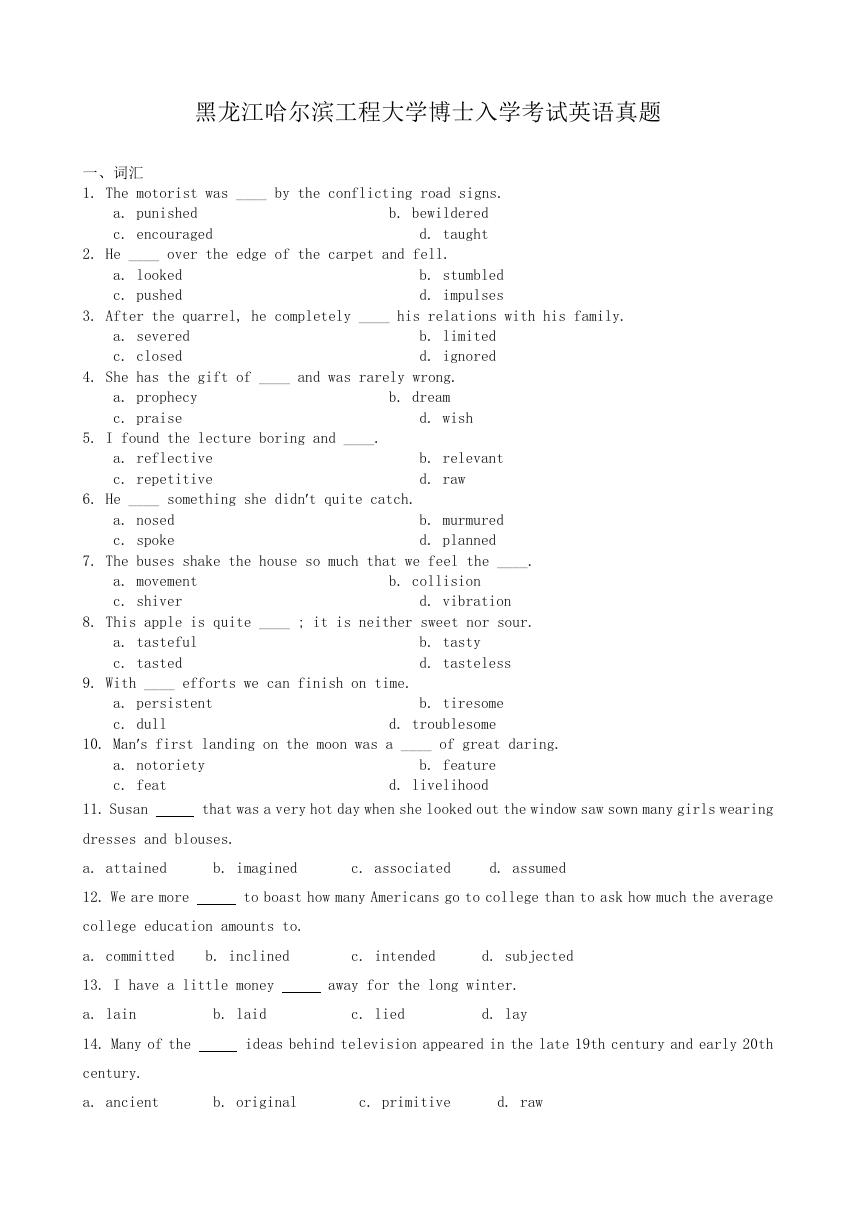
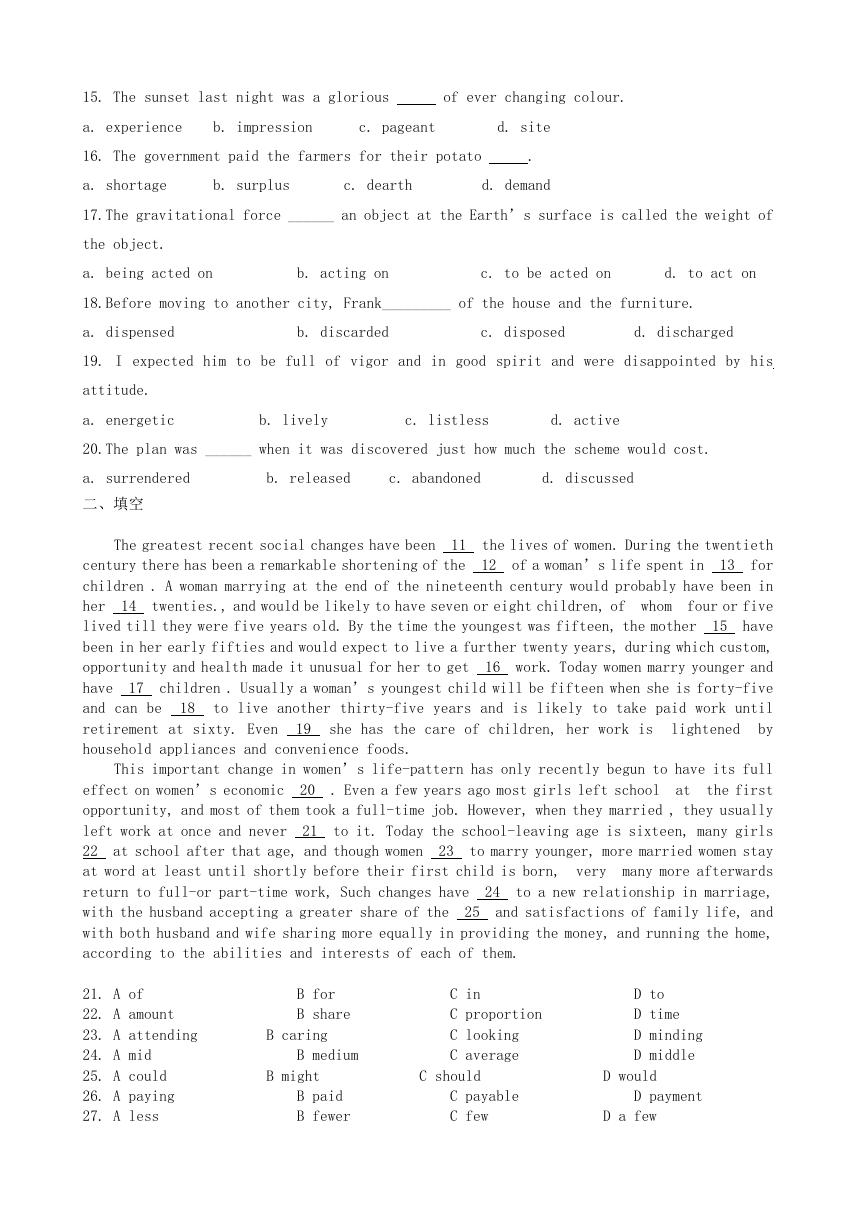
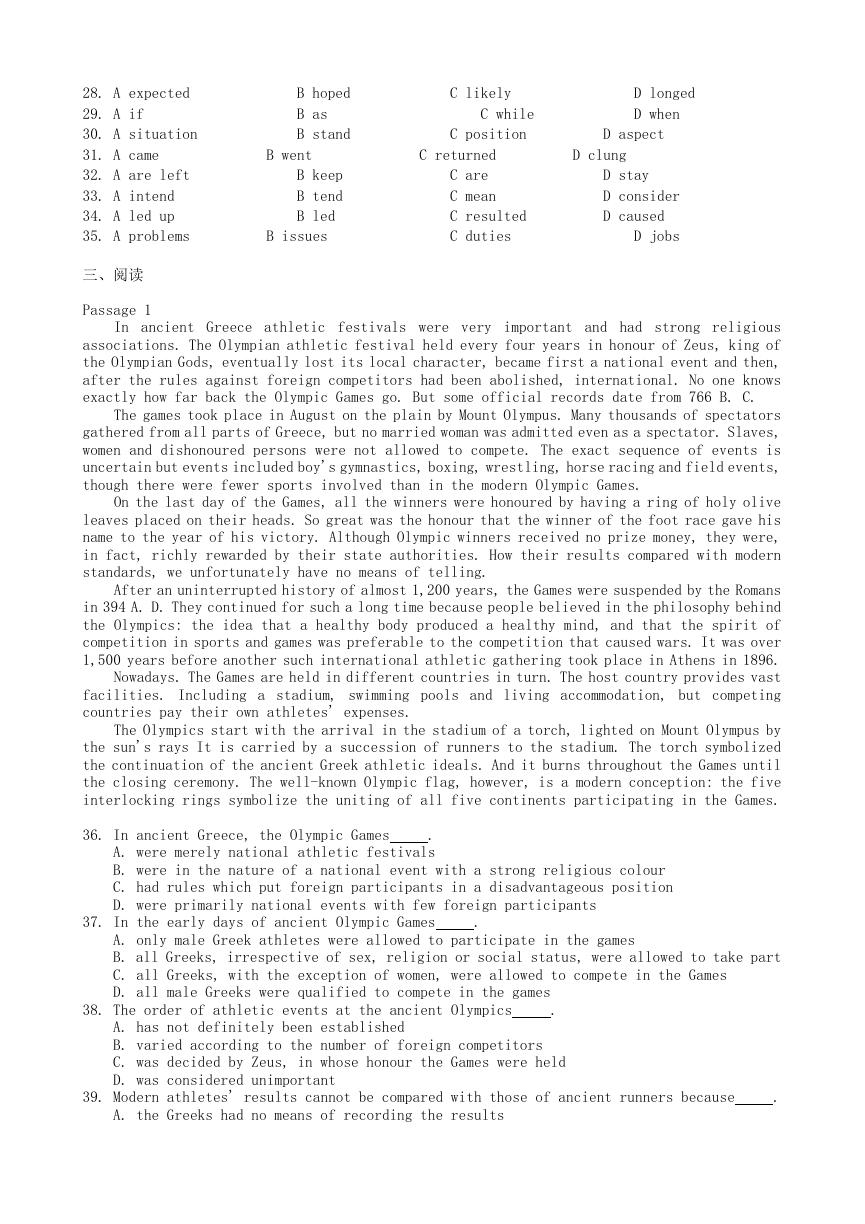



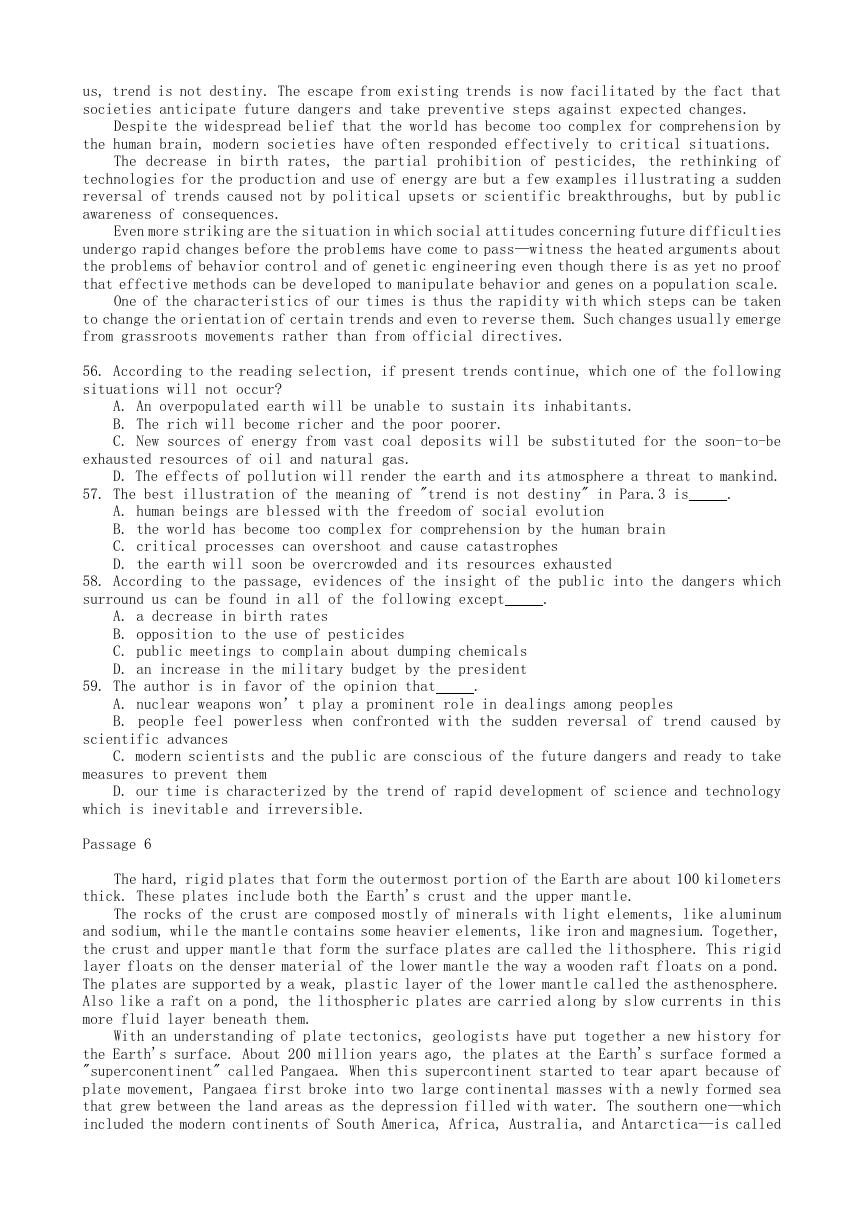
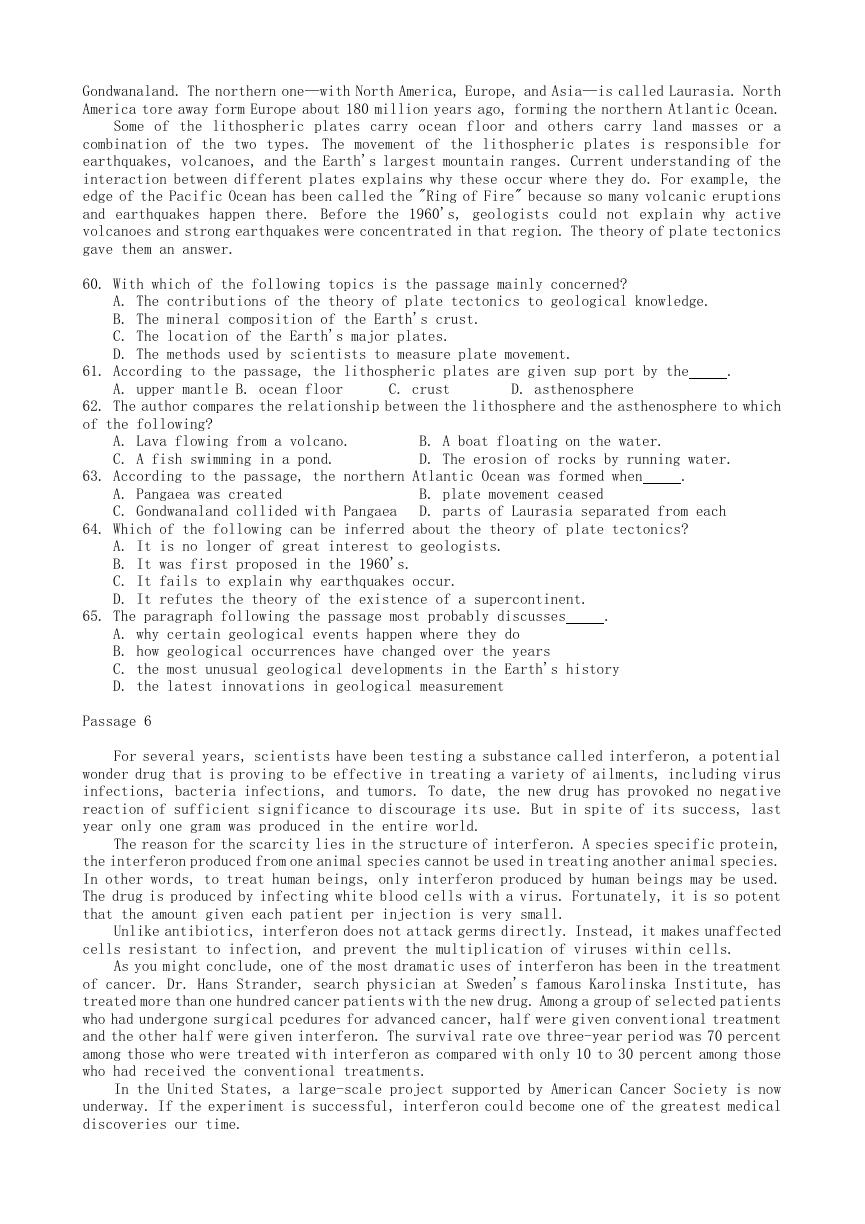








 2023年江西萍乡中考道德与法治真题及答案.doc
2023年江西萍乡中考道德与法治真题及答案.doc 2012年重庆南川中考生物真题及答案.doc
2012年重庆南川中考生物真题及答案.doc 2013年江西师范大学地理学综合及文艺理论基础考研真题.doc
2013年江西师范大学地理学综合及文艺理论基础考研真题.doc 2020年四川甘孜小升初语文真题及答案I卷.doc
2020年四川甘孜小升初语文真题及答案I卷.doc 2020年注册岩土工程师专业基础考试真题及答案.doc
2020年注册岩土工程师专业基础考试真题及答案.doc 2023-2024学年福建省厦门市九年级上学期数学月考试题及答案.doc
2023-2024学年福建省厦门市九年级上学期数学月考试题及答案.doc 2021-2022学年辽宁省沈阳市大东区九年级上学期语文期末试题及答案.doc
2021-2022学年辽宁省沈阳市大东区九年级上学期语文期末试题及答案.doc 2022-2023学年北京东城区初三第一学期物理期末试卷及答案.doc
2022-2023学年北京东城区初三第一学期物理期末试卷及答案.doc 2018上半年江西教师资格初中地理学科知识与教学能力真题及答案.doc
2018上半年江西教师资格初中地理学科知识与教学能力真题及答案.doc 2012年河北国家公务员申论考试真题及答案-省级.doc
2012年河北国家公务员申论考试真题及答案-省级.doc 2020-2021学年江苏省扬州市江都区邵樊片九年级上学期数学第一次质量检测试题及答案.doc
2020-2021学年江苏省扬州市江都区邵樊片九年级上学期数学第一次质量检测试题及答案.doc 2022下半年黑龙江教师资格证中学综合素质真题及答案.doc
2022下半年黑龙江教师资格证中学综合素质真题及答案.doc